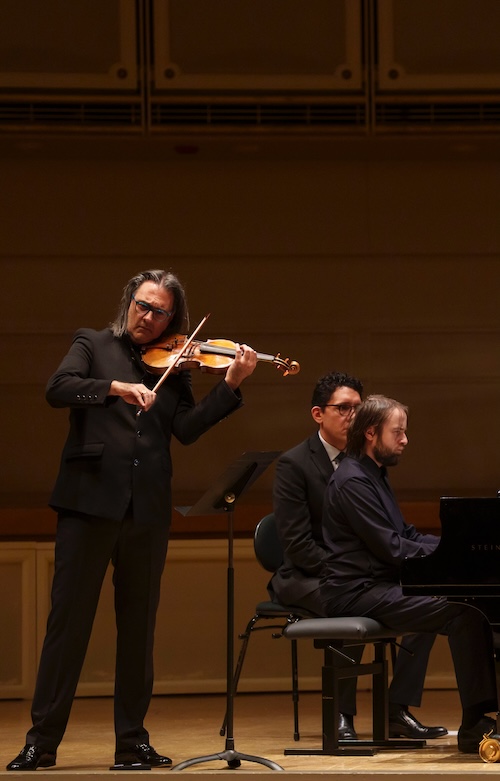Opposites attract with inspired partnership of Trifonov and Kavakos

Daniil Trifonov and Leonidas Kavakos would not be the first musicians one would think of as complementary recital partners. The Russian pianist is renown for his airtight technique and highly polished virtuosity while the Greek violinist tends to go with the flow in a more informal, sometimes eccentric approach to performing and interpretation. (The diversity extended to stage methods, with Trifonov relying on a traditional human as page turner while Kavakos employed an iPad with wireless foot pedal.)
Yet rather than two strong musical temperaments colliding, the duo proved to be cordial and mostly simpatico partners in a successful program in Chicago at Symphony Center, the final date on their five-city tour. Sunday’s matinee was also the middle event of Trifonov’s local appearances as CSO artist-in-residence this season. (He will return in May to perform Brahms’ Piano Concerto No. 2 with Klaus Mäkelä on the podium.)
Beethoven’s Violin Sonata No. 4 led off the program and served as a fine calling card for the unlikely duo. One of the less frequently heard of Beethoven’s ten works in the genre. Op. 23 often seems to look back towards Haydn and Mozart. In the opening Presto—a rare tempo for a first movement—Trifonov lightened his touch to suit the music as well as to effectively balance with Kavakos’s lean, astringent tone, setting the style for the afternoon.
The two had the full measure of the work, in synch with the jumpy energy of the opening movement, while bringing gracious charm to the bifurcated Andante scherzoso. The finale is more characteristic of the composer, and the musicians built up the tension and drama before dialing back for the gentle coda.
Francis Poulenc was not fired with enthusiasm when writing his only completed Violin Sonata. Were it not for the fact that it was a collaboration with the celebrated violinist Ginette Neveu, he likely would never have finished the commission, which the two premiered in 1943. Sadly, the finale’s marking of Presto tragico turned out to be prescient, with Neveu perishing in a plane crash just a few years later, age 30.
Poulenc’s wartime sonata is an edgy, haunted work and despite its occasional clunky moments—especially in the first movement—Kavakos and Trifonov made an impassioned case for this music. The two fairly leapt into the violent oscillations of the opening movement, fluently relaxing for the second theme. Kavakos gave feeling to the ensuing pensive melody before the agitated opening music returned to close the movement.
The central Intermezzo provided contrast as well as some balm (Très lent et calme), though a certain unease remained with Kavakos’s abraded lyricism set against Trifonov’s poised expression. The players charted the finale most effectively—the first section nearly unhinged in its frenzied energy and the subdued finale, with Trifonov’s resigned piano and Kavakos’s bleak isolated violin notes, making for an unsettling close.
Kavakos was the dominant figure in Brahms’ Violin Sonata No. 1 in G major, one of the most sheerly beautiful inspirations of the composer’s vast chamber output.
The first movement is invariably taken at a slower tempo than its marking (Vivace ma non troppo), and the musicians’ expansiveness was clearly attuned to Brahms’ characteristic vein of reflective introspection, while subtly moving faster to firmly etch the more assertive coda.
Led off by Trifonov’s stately piano, Kavakos luxuriated even more in the ensuing Adagio, albeit with some slurry phrasing and a brief pitchy moment, though both largely sustained this interior meditation with the focused expression of their playing.
Still, there are limits and the leisurely, soft-focus approach continued in the finale, the single dubious artistic decision of the program. In addition to failing to provide the incisive bite and vigor the music requires, the excessive languor sacrificed essential contrast with the slower middle section. Still, the duo handled the concluding section well, closing on just the right note of relaxed repose.
Béla Bartók’s Rhapsody No. 1 closed the program. Dedicated by the composer to his friend and recital partner Joseph Szigeti, the First Rhapsody mines both Hungarian and Romanian folk influences, elements realized with great relish by both musicians. In the Lassù opening section, Trifonov’s piano fairly morphed into a clanging cimbalom, and the grain in Kavakos’s sound reflected the febrile gypsy strains. Both men brought a playful quality to the brilliant music of the closing section (Friss) with Kavakos throwing off the fireworks in spirited, populist style.
Trifonov and Kavakos closed the afternoon with an encore of the Andantino from Schubert’s Violin Sonata No. 4 in A Major (“Grand Duo”) rendered with delicacy and effervescent charm.
Symphony Center Presents’ next chamber event takes place 3 p.m. March 30 with violinist Julia Fischer and pianist Jan Lisiecki performing violin sonatas of Mozart, Beethoven and Schumann. cso.org